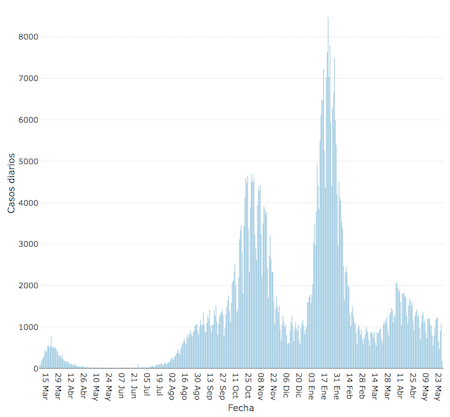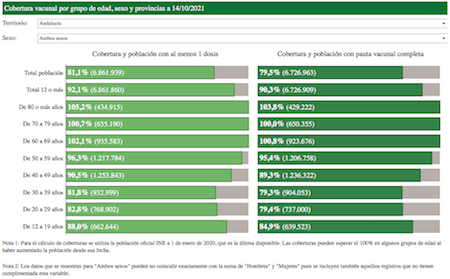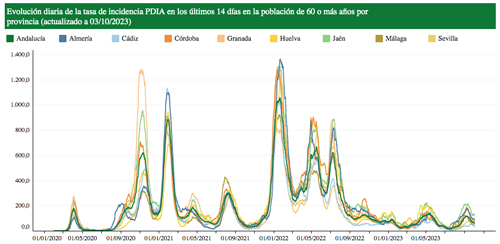In March 2020, Spain began a lockdown that would come & go for well over a year. As we descend from the fourth wave of infection, now seems like a good time to reflect on national & local management of the pandemic. My personal experience in Andalucía should not be considered standard for the entire country; other regions of Spain have had wildly different circumstances. Hindsight is of course 20/20, but I’ll try to address the good, the bad & the unfortunate, occasional ugly. Enjoy the rollercoaster ride like the graph above (taken from the Ministerio de Sanidad).
Too late?
Did Spain wait too long to lockdown? Probably. Neighboring countries faced the same dilemma, & similar responses occurred across the European Union. No one had a realistic idea of the death toll COVID-19 would bring. I didn’t think its effects would be as devastating either, because everyone assumed this virus spread like the flu… with deadlier symptoms but preventable using simple measures. Wishful thinking.
Geneticists ruled out the existence of a patient zero for Spain & found that COVID-19 had been in the country since mid-February 2020. Entering via Madrid & Valencia, football fans from a match in Milan as well as Fashion Week attendees carried the virus from Italy. Foreign tourists also brought the virus to both the Canary & Balearic Islands, & a February funeral in the Basque Country acted as a super-spreader event. The first Spanish case of local contagion (infection without travel or contact with travellers) happened in Sevilla where I lived. The devastating nature of the virus soon began to raise red flags everywhere.
Andalucía followed national guidelines as Spain approved an estado de alarma with all decisions determined by the central government. The state of alarm could only last for fifteen days according to the constitution, so quarantine had to be approved over & over again. Politicians took advantage of the situation —surprise, surprise— to try to weaken the Socialist party in charge while over 1,000 people died daily. Political maneuvering by conservative parties PP & Vox took precedence over the lives of citizens. Disgusting.

A shared experience?
As bad as Spain fared, other countries in the European Union had it worse. News reports, both national & regional, shared the difficulties of our neighbors & generated a sense of common struggle & unity. As in many other places, we came to balconies or windows at 20:00 to give a round of applause for healthcare workers bearing the brunt of the pandemic.
In my neighborhood, this show of support quickly devolved into political posturing. People next door would play the national anthem at 20:00 sharp, then shout “¡Viva España!” from their rooftop. Some nearby houses would answer with the standard callback of “¡Viva!“… an obvious display of military, conservative & even Fascist sympathies. My husband got so angry a few nights that he countered with the Andalucía hymn blasting as loud as possible, basically the antithesis of Spanish conservatism. At least we witnessed the real political leanings of our barrio. What could have brought us together as a neighborhood only reinforced divisions that haven’t been resolved since 1939. Good god, Spain, get a grip.
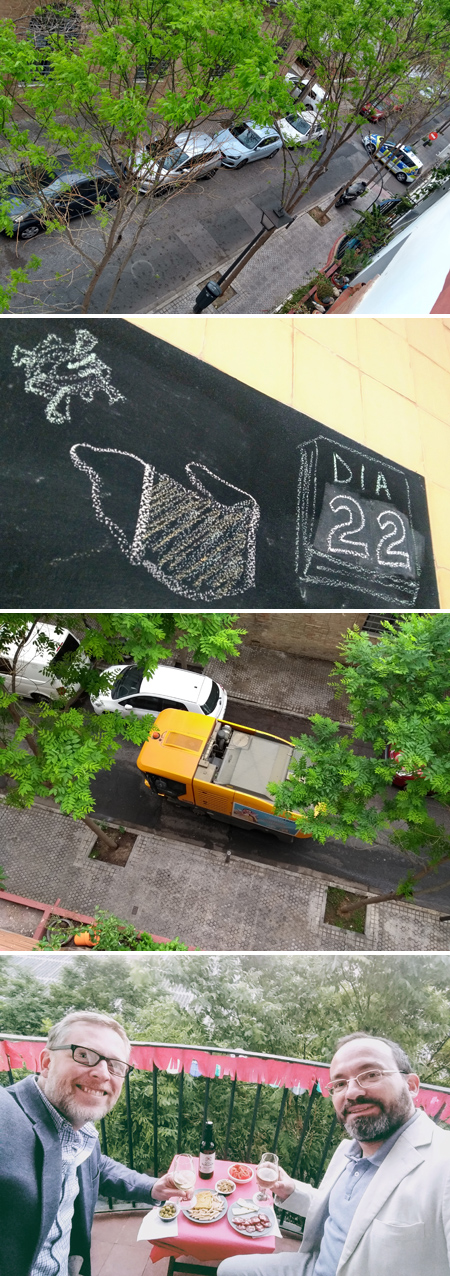
Contact tracing?
Despite proven effectiveness in managing local outbreaks, Spain never fully embraced contact tracing, even when the Armed Forces offered troops to man the phones. Minimal effort & downplay on the news made this preventive measure disappear fast. Likewise for the Bluetooth tracing app RadarCOVID. As I write this, the app has been downloaded by about 7.3 million people… a sad figure for a population of 48 million people with over 41 million devices. Only 63,000 positive cases have been registered on the app since release, an underwhelming 1.7% of recorded cases in Spain to date. Two very wasted opportunities.

Was the worst over?
May began, we could go outside during certain hours for exercise —only within a 1 km radius of our residence— summer showed signs of coming soon, & masks were finally made mandatory. Sevilla was slow to adapt to masks although required by law. Our weather makes them uncomfortable, but not as uncomfortable as being in a hospital on a ventilator! As Rafa said, someone should do a study titled “La mascarilla y la frágil masculinidad” (Face Masks & Fragile Masculinity). We saw many couples walking hand in hand but with only the woman wearing a mask. Ahhh, Spain.

A major result of political bickering during the first wave was devolution of pandemic management to regional governments. June & July brought summer vacations for many people although I was still cautious. Maybe overly so. However, we quit disinfecting our groceries at home & Rafa went to visit family in Málaga. We toyed with the idea of visiting my aunt in August, but just as case numbers in Europe began to stabilize they went through the roof in the US. Good thing airlines gave vouchers because the second wave hit Spain in August… all those vacations turned out to be a bad idea. Add the UK variant to the mix & case numbers skyrocketed.
Months of prep in Andalucía for another outbreak meant the death toll never reached that of the first, but in my book even one death is too many. And who wants to deal with possible long-term effects of being infected? Teenagers thought themselves invincible as warm temps revived botellones —loud drinking parties in public space— despite laws in place to prevent them. Police ran ragged & even stopped answering the phone due to the number of complaints.
Saving Christmas?
By the end of October, regional governments knew they could not legally restrict mobility & worried about another wave of infection during the holidays. A new estado de alarma passed approval —in spite of abstention by the Partido Popular & Vox voting against it— that would last six months with congressional review every two weeks. Fantastic.
A national curfew was set from 23:00 to 06:00 daily, & those hours could be modified by regional governments. Andalucía added an hour of curfew to each end (22:00 to 07:00), closed regional borders as well as limited municipal & provincial mobility. We joked about not being able to go to IKEA just across the river, but keeping people close to home plus limiting business hours helped control the virus. At the beginning of December, case numbers finally dropped to August levels.
Pushed by the Partido Popular in Madrid, an idea emerged to boost the economy & “salvar la Navidad.” In the end, this brief relaxation of restrictions turned out to be more costly… in terms of lives lost, in money spent on testing & long hospital stays. The third wave exploded after the holiday season ended on January 7th (see the largest peak, top of page):
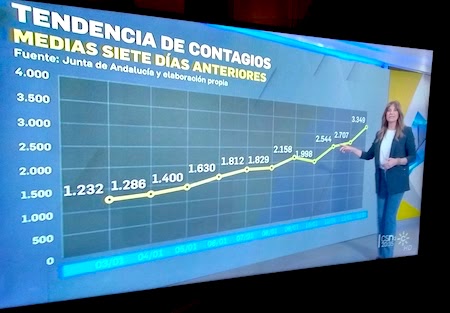
Where’s the vaccine?
Vaccination began on 27 December 2020, with the oldest & most vulnerable population first. As cases hit their highest level ever, people seemed less concerned about the pandemic since vaccines were on the way. But slow rollout made swift vaccination impossible. Andalucía blamed the central government who in turn blamed the European Union.
Pfizer & Moderna arrived piecemeal, AstraZeneca experienced delays, & Andalucía stopped administering AstraZeneca due to fear of stroke side effects. Janssen (Johnson & Johnson) fizzled out as well with similar problems. Twelve weeks passed while tests combining AstraZeneca & Pfizer were carried out. An initial plan to stockpile 20% of received vaccines broke down as they decided to distribute them all… currently the last of the 50-year old age group is receiving their first dosis. And here we are.
Biggest failure
Media coverage has focused almost exclusively on numbers & lacks intuitive graphs to explain the evolution of the pandemic. Tracking progress is vital but not at the expense of dehumanizing victims. Canal Sur has been particularly bad by failing to interpret data or rarely mentioning previous waves… just night after night of non-stop numbers.
Even worse, networks used stock footage of hospitalizations for weeks at a time. Repetition of the same images lessens the value of health care workers, & I can only remember one instance of nurses being interviewed on Canal Sur. It was emotional. Where are first-hand reports of those who save lives? Where are reports of family members who have lost loved ones? Mass media has failed to make the pandemic personal, so people let down their guard.
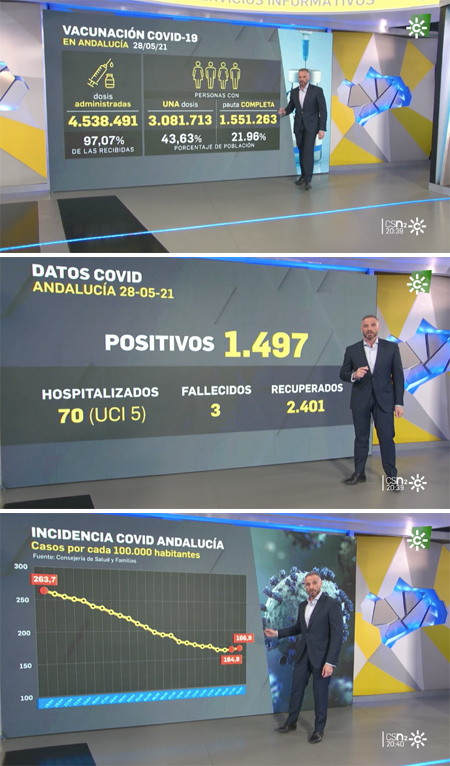
Biggest success
Andalucía has excelled in vaccine distribution. As soon as a shipment arrives from Madrid, vaccines are spread throughout the region —we are the largest in Spain with almost 8.5 million residents— & administered in drive-thru garages, conference centers, university buildings, sports arenas, or anywhere large enough to handle a quick flow of people. They even discussed using bullrings if necessary!
Last week alone, almost half a million doses were administered & supposedly the system can handle twice that… if only vaccines were available. The Health Minister even got 15 seconds of fame when his speech about combining the culillo from various vaccine bottles (literally, “little ass” or that tiny, leftover droplet) to make a full dosis. Colloquial expressions aside, the system seems to function well.
As parts of the world return to some version of normality, Spain still struggles. Hospitalizations have decreased, but daily infection rates & accumulated incidence numbers are not falling in Andalucía like they should. Specialists believe this may be due to a younger population being infected at an alarming rate but not in need of hospital services… we’ll see where the delta variant takes us! Many thanks to Amanda & David for our weekly video chats that helped maintain my sanity through this entire ordeal.
Update (14 Oct 2021): Time for cautious celebration since over 90% of the population of Andalucía age 12 & up is fully vaccinated!! Also, all health districts with the exception of two in Almería have under 50 cases of COVID per 100,000 residents (Level 0). With such low risk, all restrictions limiting the number of people in any given space have been lifted. Masks are still required indoors until Spring 2022, but case rates haven’t been this low since the pandemic began.
Will this situation continue? It’s anyone’s guess since we have the holidays arriving soon, & most vaccines have shown to be less effective after six months. A third dosis has been approved for the elderly, so maybe the rest of us will receive another at some point in the future. But for now, we can exhale… preferably with masks on.
Update (Apr 2024): As of Oct 2023, government organizations stopped tracking COVID cases. Seems like an odd thing to do, but now we get a picture of the entire pandemic. That was a rollercoaster ride, but now we have to deal with norovirus thanks to the huge increase in tourism throughout the region. Lovely.
